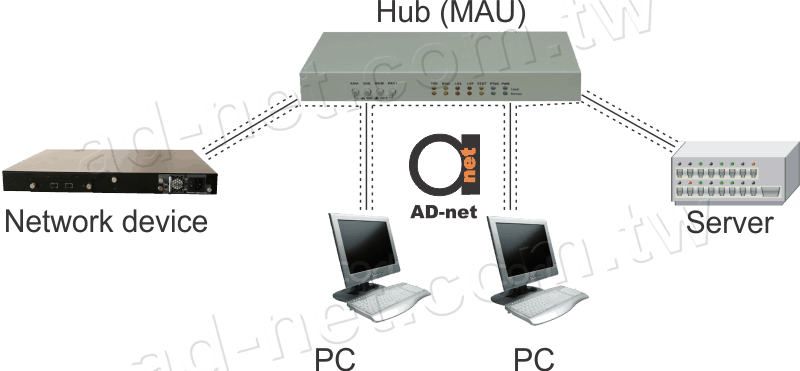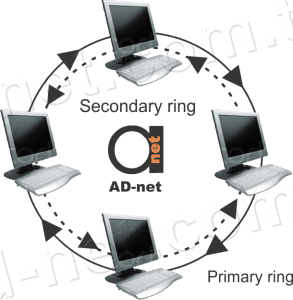Token Ring
As the alternative to Ethernet, IBM developed its own solution for the networking design called Token Ring. Network designed as ring or star-ring hybrid was based around the idea of a free token signal traveling freely around the network and waiting to be picked up by a node that requires transmission. Node that possess the free token is able to create Token Ring data frame and send it together with busy token. Receiving end would acquire data and send out the “data received” acknowledgement. If there is no problem, sender releases free token to circulate in the network. The process takes milliseconds, so there is no noticeable delay for any node.
In star-ring topology data should travel down and up every lobe that is connected to hub. It makes possible for “virtual” ring topology. In order to avoid any complications when the lobe is disabled or broken, hubs implement technology allowing to disable single lobe therefore continuously providing fully connected ring topology at all times.
Original design was using STP (Shielded Twisted Pair) for the Token Ring. It had unique connectors which were hermaphrodic (no male/female) allowing direct interconnection between cables. Later on UTP (Unshielded Twisted Pair) was used, switching to more popular eight pin connectors. Technology was depreciated due to popularity of the Ethernet. Currently Token Ring networks can support either 4Mbps or 16Mbps. They cannot support both at the same time (unlike Ethernet with 100/1000 Mbps).

FDDI (Fiber Distributed Data Interface)
FDDI was designed for fiber optic cable, later adopting copper cabling. At first glance it appears to be similar to the Token Ring with only several (but significant) differences. When the node is in possession of free token it can transmit as much data as it needs within the strictly defined time. After time is up, it has to give-up the free token.
FDDI requires ring or star-ring topology, but unlike Token Ring some of the NIC cards can have two FDDI interfaces. Each port is configured to be a receiver for one ring and a transmitter for another ring. This type of node is called DASs or Dual Attached Stations. The one can only imagine how big are the complications for this kind of cabling. In some cases only critically important components of the network are using dual interface NICs while workstations have only single ones.

ATM (Asynchronous Transfer Mode)
ATM was developed as a high-speed network protocol that can work in any topology or any LAN configuration. It can be used for real-time voice and video, as well as data transmission.
ATM relies on virtual connection between sender and receiver. Data is sent in parts and is arranged and assembled at the receiver end. That way different data packages can take different routes to get to the receiver.
Data speeds varies from 1.5 Mbps to 155 Mbps in copper and up to 622 Mbps in fiber optics. Due to being future proof and relatively low cost, most of modern network designs rely on optic fiber for ATM.


